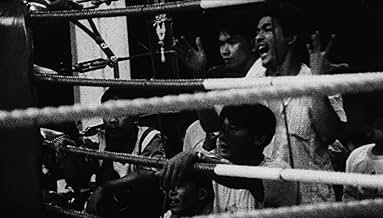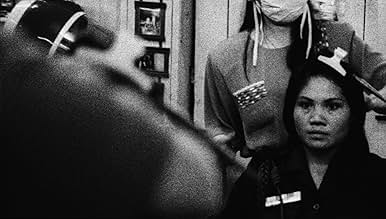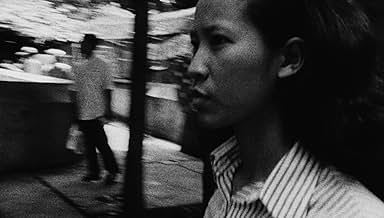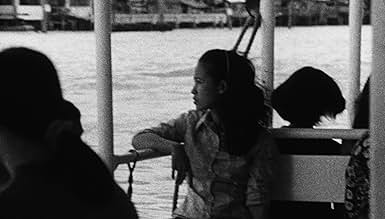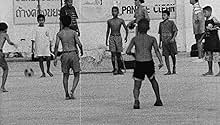IMDb RATING
6.7/10
1.8K
YOUR RATING
A film crew documents a folk story-exquisite corpse combination by random Thai people; the story is reenacted.A film crew documents a folk story-exquisite corpse combination by random Thai people; the story is reenacted.A film crew documents a folk story-exquisite corpse combination by random Thai people; the story is reenacted.
- Awards
- 4 wins & 4 nominations total
Featured reviews
i took my girlfriend to see this one after reading a very promising article about it in my monthly cinema newspaper. i regretted it after about 15 minutes of the movie. the main idea to it, to let a story develop by it's protagonists, thus making it a semi documentary, seems promising, but suffers under the usual problems movies have that relay on their actors as directors. they are non. so the movie is constantly on the verge of failure, while thru most parts being plain - i am sorry, but i have to use that word - boring. it is, as the short movies of weerasethakul, heavily based on long steady shots and seemingly unconnected pieces of sound and dialog. this may work as an installative work in an art context but definitely fails to deliver when watching it for about 90 minutes in a cinema. the only refreshing moments of the movie are the ones of self reference. one in which one assistant of the director appears, telling him that the whole thing does not work and that they better should have written a script, and one in which a kid actor is asking if he finally can go home (and if not, if afterwords he at least can get a burger at kfc :). i have to admit i really felt with the kid.
"Mysterious" held much dramatic promise.
But because of its hybrid innovation, I'm at a lost as to rate it as a dramatic feature or a documentary film. Either way, despite its critical accolades, it wasn't able to interest me enough to wanna cradle its inadequacies. Poor film making craft is inexcusable even if this feature is excusably in a league of its own. (And did anyone catch a moment of Ozu homage in one of the scenes, with children walking by at one end and the camera placed at another? Nice...)
That said, there were undeniable moments of brilliance in it. Two standouts come to mind; The "banter" between the two mute girls and that staged re-enactment by the villagers. And it shown the director to be one who knows how to capture such cinematic sparks, albeit inconsistently.
I thus hope to see "Blissfully yours" before I decide on my regard for Apichatpong Weerasethakul as a film maker. Similarly, "Mysterious" will be given the benefit of the doubt. For honestly, it just didn't hack it for me right now.
But because of its hybrid innovation, I'm at a lost as to rate it as a dramatic feature or a documentary film. Either way, despite its critical accolades, it wasn't able to interest me enough to wanna cradle its inadequacies. Poor film making craft is inexcusable even if this feature is excusably in a league of its own. (And did anyone catch a moment of Ozu homage in one of the scenes, with children walking by at one end and the camera placed at another? Nice...)
That said, there were undeniable moments of brilliance in it. Two standouts come to mind; The "banter" between the two mute girls and that staged re-enactment by the villagers. And it shown the director to be one who knows how to capture such cinematic sparks, albeit inconsistently.
I thus hope to see "Blissfully yours" before I decide on my regard for Apichatpong Weerasethakul as a film maker. Similarly, "Mysterious" will be given the benefit of the doubt. For honestly, it just didn't hack it for me right now.
An interesting film, more for the idea behind it and moments captured than the overall execution.
A filmmaker rolls around town in search of a story, making the film we see. It begins with long footage of driving around Bangkok, then we segue to the story proper with a woman being interviewed, asked about a story.
The story is made-up, the point is not the story of course, but dismantling the conventional telling. Different people are interviewed who bend the story to their fancy, adding stuff. We are not entirely sure who among them are actors coached on what to say, who are passers-by blurting out what comes in their heads. We can tell that some of it was obviously blocked to be filmed, some covertly staged as real and some stolen from glances but the whole is pretty seamless.
This is an opportunity to film all sorts of activities and splice it together to see what kind of sense comes out; among them an amateur theatric production of the story, a simulated TV interview filmed off the TV, (faux?) newsreel footage, real scenes of boxing, a singing contest and sex show, a scene from the film but the camera keeps rolling through the break. When the crippled boy is assigned a random background by one of the interviewees, in the following scene his teacher acquires the same background of war and family loss.
In the West, we have similar films of stories about stories in Saragossa Manuscript and such, where usually the point is structure, hidden meaning and the divination of self.
In the East, specifically Thailand, they have their own traditions of light storytelling and meta-narrative sorting of concepts, both defined by cultural proximity to India. Among the three 'holy' texts of their native Buddhism is a body of work called Abhidharma, teachings about the teachings. Composed after the Buddha's time, commentaries upon commentaries form a complex, layered web of cataloguing various ontological attributes of reality, phenomena and self. Boring if you ever try to read it.
On a historical note, there is evidence that abhidharmic influence in the north of India in turn rippled West through Persia to influence gnostic thought, and East through the Silk Road as both reaction to its scholasticism and elaboration of it contributed to early Chinese Buddhism. In both cases, the distinction is made between mere intellectual reasoning in the abhidharmic vein, and expansive meditative wisdom that looks directly at things. (respectively, gnosis and prajna)
Anyway, the film has no direct link to all that except as pointing to the mesh of meta-narrative.
And it's cool to note that springing from a Buddhist background, in this film of stories about stories the stories are transient, illusory confabulations, there's no intrinsic meaning or symbolism to them, there's no structure beyond co-dependent arising of narrator and image, and the narrator is neither a single self nor on some journey to enlightenment. Nice, if you don't burden yourself with futilely trying to organize the tangle, just directly look at the wondrous nothingness.
The last story is made-up by schoolchildren, collapsing in a fantastical, meaningless heap of witch tigers and magical swords, illusory child's play.
The closing shots are of children kicking a ball, the rush of actual life outside the stories which is the most mysterious object of all.
A filmmaker rolls around town in search of a story, making the film we see. It begins with long footage of driving around Bangkok, then we segue to the story proper with a woman being interviewed, asked about a story.
The story is made-up, the point is not the story of course, but dismantling the conventional telling. Different people are interviewed who bend the story to their fancy, adding stuff. We are not entirely sure who among them are actors coached on what to say, who are passers-by blurting out what comes in their heads. We can tell that some of it was obviously blocked to be filmed, some covertly staged as real and some stolen from glances but the whole is pretty seamless.
This is an opportunity to film all sorts of activities and splice it together to see what kind of sense comes out; among them an amateur theatric production of the story, a simulated TV interview filmed off the TV, (faux?) newsreel footage, real scenes of boxing, a singing contest and sex show, a scene from the film but the camera keeps rolling through the break. When the crippled boy is assigned a random background by one of the interviewees, in the following scene his teacher acquires the same background of war and family loss.
In the West, we have similar films of stories about stories in Saragossa Manuscript and such, where usually the point is structure, hidden meaning and the divination of self.
In the East, specifically Thailand, they have their own traditions of light storytelling and meta-narrative sorting of concepts, both defined by cultural proximity to India. Among the three 'holy' texts of their native Buddhism is a body of work called Abhidharma, teachings about the teachings. Composed after the Buddha's time, commentaries upon commentaries form a complex, layered web of cataloguing various ontological attributes of reality, phenomena and self. Boring if you ever try to read it.
On a historical note, there is evidence that abhidharmic influence in the north of India in turn rippled West through Persia to influence gnostic thought, and East through the Silk Road as both reaction to its scholasticism and elaboration of it contributed to early Chinese Buddhism. In both cases, the distinction is made between mere intellectual reasoning in the abhidharmic vein, and expansive meditative wisdom that looks directly at things. (respectively, gnosis and prajna)
Anyway, the film has no direct link to all that except as pointing to the mesh of meta-narrative.
And it's cool to note that springing from a Buddhist background, in this film of stories about stories the stories are transient, illusory confabulations, there's no intrinsic meaning or symbolism to them, there's no structure beyond co-dependent arising of narrator and image, and the narrator is neither a single self nor on some journey to enlightenment. Nice, if you don't burden yourself with futilely trying to organize the tangle, just directly look at the wondrous nothingness.
The last story is made-up by schoolchildren, collapsing in a fantastical, meaningless heap of witch tigers and magical swords, illusory child's play.
The closing shots are of children kicking a ball, the rush of actual life outside the stories which is the most mysterious object of all.
A camera attached to a moving car takes us down a busy city street in Thailand. Abruptly, the car turns into a narrow alley where we see brush grass and run down shacks. As the camera enters one of the houses, a heavy-set woman speaks of the trauma involved in her being sold into prostitution by her father. When she is finished, an off-camera voice asks her to tell another story, real or fiction. It is then that we begin to sense that cinematically we are in unchartered territory. Internationally acclaimed Thai director Apichatpong Weerasethakul's first feature Mysterious Object at Noon is an offbeat mixture of reality and fiction in which there is no screenplay or linear narrative, only a story created and added to by each participant in the mode of the French game "exquisite corpse".
The story the woman first tells is that of a teacher named Dogfahr whose young pupil is a cripple confined to a wheelchair. The tale is then dramatized on screen by non actors alternating with the talking storyteller. As the camera moves north and south of Bangkok into the Thai countryside, a cross section of Thai's continue the story by adding a few lines. These include two deaf girls using sign language, a song and dance troupe, and children in a rural Thai school. With each addition, the tale becomes vastly different and increasingly fantastic. The mysterious object in the title falls from the teacher who has collapsed and turns into an extraterrestrial boy with strange powers, a duplicate teacher, and finally a "witch tiger" and a magic sword.
Some sequences stand by themselves and are without any relation to the continuing storyline. The teacher brings her father to the doctor for a hearing test and complains of a strange line around her neck which the doctor dismisses as an allergy or the effect of wearing her necklace. Parents talk of a boy who escaped death in a plane crash because he was protected by amulets, and a scene shows women bargaining at a fish market. An experimental film with a small budget shot in 16-millimeter black and white, Mysterious Object at Noon glows with warmth and playfulness. As it progresses, it also slows down and becomes more of a meditation on Thai culture, creating a mood of tranquility and peace. Like Seinfeld, it is ostensibly "about nothing", but turns out to be about everything.
The story the woman first tells is that of a teacher named Dogfahr whose young pupil is a cripple confined to a wheelchair. The tale is then dramatized on screen by non actors alternating with the talking storyteller. As the camera moves north and south of Bangkok into the Thai countryside, a cross section of Thai's continue the story by adding a few lines. These include two deaf girls using sign language, a song and dance troupe, and children in a rural Thai school. With each addition, the tale becomes vastly different and increasingly fantastic. The mysterious object in the title falls from the teacher who has collapsed and turns into an extraterrestrial boy with strange powers, a duplicate teacher, and finally a "witch tiger" and a magic sword.
Some sequences stand by themselves and are without any relation to the continuing storyline. The teacher brings her father to the doctor for a hearing test and complains of a strange line around her neck which the doctor dismisses as an allergy or the effect of wearing her necklace. Parents talk of a boy who escaped death in a plane crash because he was protected by amulets, and a scene shows women bargaining at a fish market. An experimental film with a small budget shot in 16-millimeter black and white, Mysterious Object at Noon glows with warmth and playfulness. As it progresses, it also slows down and becomes more of a meditation on Thai culture, creating a mood of tranquility and peace. Like Seinfeld, it is ostensibly "about nothing", but turns out to be about everything.
This approaches art, and does so from an oblique angle and in an exotic locale. That being said for me, it never achieves that art., Despite the loose effort to stitch a thread of a story through this, and some curious disjointed elements, the whole does not hold.
See this film if you are willing to bring a lot to the party. (And kudos to you, davidals@msn.com) Or play it in your rental store, or during a party with the sound off, and it will probably snare more fish than it does standing alone with you and your remote.
I'm all for experimental film, this could have been whittled down to a 7 minute beauty for the Ann Arbor Film Fest; at 83 min, it came across as a chore, a corpse less than exquisite. And while I'm coming across as the anti-hipster, why black (or almost a dusty brown) and white for this film? Color I think would have made this more florid and captivating, although perhaps more common-place and thus undermined the art?
Wait till your film professor assigns this one to you.
3/10
See this film if you are willing to bring a lot to the party. (And kudos to you, davidals@msn.com) Or play it in your rental store, or during a party with the sound off, and it will probably snare more fish than it does standing alone with you and your remote.
I'm all for experimental film, this could have been whittled down to a 7 minute beauty for the Ann Arbor Film Fest; at 83 min, it came across as a chore, a corpse less than exquisite. And while I'm coming across as the anti-hipster, why black (or almost a dusty brown) and white for this film? Color I think would have made this more florid and captivating, although perhaps more common-place and thus undermined the art?
Wait till your film professor assigns this one to you.
3/10
Did you know
- TriviaFilming was carried out for three years with a volunteer crew, and only stopped when the camera broke down - the last shot of the movie is literally the last piece of film that passed through the camera.
- ConnectionsFeatured in 40 Days to Learn Film (2020)
- How long is Mysterious Object at Noon?Powered by Alexa
Details
- Release date
- Countries of origin
- Languages
- Also known as
- Heavenly Flower in Devil's Hand
- Production companies
- See more company credits at IMDbPro
- Runtime1 hour 29 minutes
- Color
- Sound mix
- Aspect ratio
- 1.37 : 1(original 16mm negative ratio)
Contribute to this page
Suggest an edit or add missing content

Top Gap
By what name was Mysterious Object at Noon (2000) officially released in India in English?
Answer

